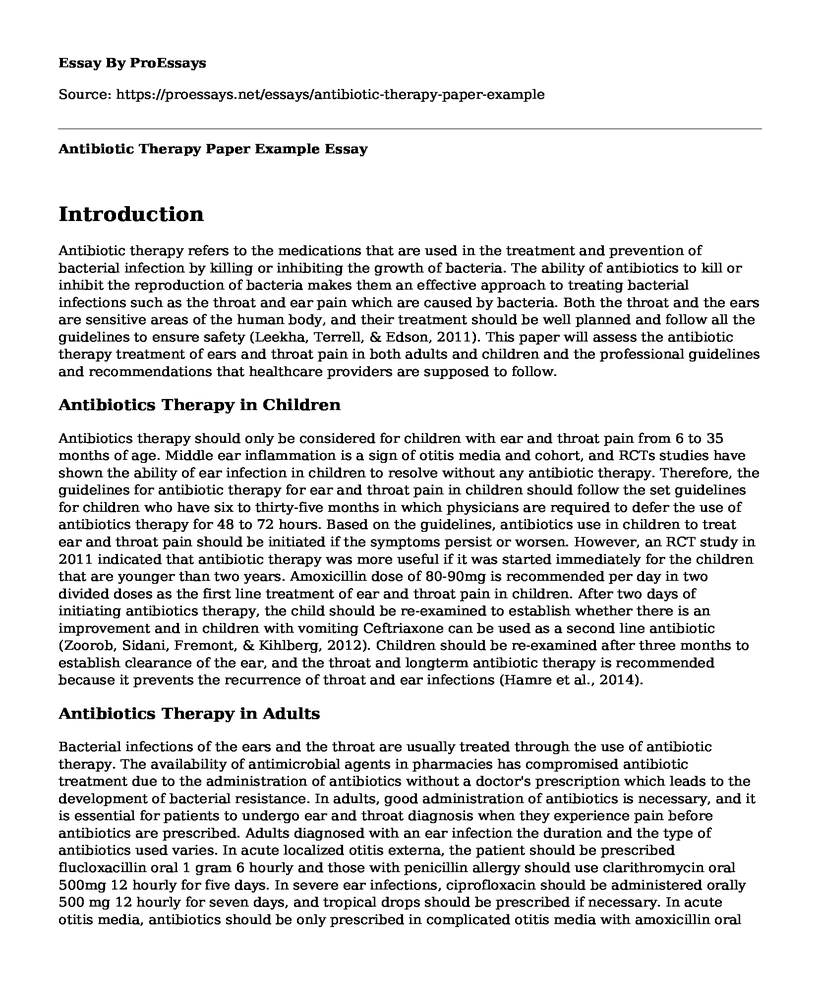Introduction
Antibiotic therapy refers to the medications that are used in the treatment and prevention of bacterial infection by killing or inhibiting the growth of bacteria. The ability of antibiotics to kill or inhibit the reproduction of bacteria makes them an effective approach to treating bacterial infections such as the throat and ear pain which are caused by bacteria. Both the throat and the ears are sensitive areas of the human body, and their treatment should be well planned and follow all the guidelines to ensure safety (Leekha, Terrell, & Edson, 2011). This paper will assess the antibiotic therapy treatment of ears and throat pain in both adults and children and the professional guidelines and recommendations that healthcare providers are supposed to follow.
Antibiotics Therapy in Children
Antibiotics therapy should only be considered for children with ear and throat pain from 6 to 35 months of age. Middle ear inflammation is a sign of otitis media and cohort, and RCTs studies have shown the ability of ear infection in children to resolve without any antibiotic therapy. Therefore, the guidelines for antibiotic therapy for ear and throat pain in children should follow the set guidelines for children who have six to thirty-five months in which physicians are required to defer the use of antibiotics therapy for 48 to 72 hours. Based on the guidelines, antibiotics use in children to treat ear and throat pain should be initiated if the symptoms persist or worsen. However, an RCT study in 2011 indicated that antibiotic therapy was more useful if it was started immediately for the children that are younger than two years. Amoxicillin dose of 80-90mg is recommended per day in two divided doses as the first line treatment of ear and throat pain in children. After two days of initiating antibiotics therapy, the child should be re-examined to establish whether there is an improvement and in children with vomiting Ceftriaxone can be used as a second line antibiotic (Zoorob, Sidani, Fremont, & Kihlberg, 2012). Children should be re-examined after three months to establish clearance of the ear, and the throat and longterm antibiotic therapy is recommended because it prevents the recurrence of throat and ear infections (Hamre et al., 2014).
Antibiotics Therapy in Adults
Bacterial infections of the ears and the throat are usually treated through the use of antibiotic therapy. The availability of antimicrobial agents in pharmacies has compromised antibiotic treatment due to the administration of antibiotics without a doctor's prescription which leads to the development of bacterial resistance. In adults, good administration of antibiotics is necessary, and it is essential for patients to undergo ear and throat diagnosis when they experience pain before antibiotics are prescribed. Adults diagnosed with an ear infection the duration and the type of antibiotics used varies. In acute localized otitis externa, the patient should be prescribed flucloxacillin oral 1 gram 6 hourly and those with penicillin allergy should use clarithromycin oral 500mg 12 hourly for five days. In severe ear infections, ciprofloxacin should be administered orally 500 mg 12 hourly for seven days, and tropical drops should be prescribed if necessary. In acute otitis media, antibiotics should be only prescribed in complicated otitis media with amoxicillin oral 500mg 8 hourly for five days being the first line and the second line being co-amoxiclav oral 625mg 8 hourly (Yoon et al., 2017). In throat infections in adults can be caused by viruses which make antibiotics futile and should only be used in patients with pain and fever. In throat pain, ampicillin or amoxicillin can be used. It is recommended, for the healthcare providers to assess the patient's allergy status and all the clinical criteria should be documented (Leekha et al., 2011).
References
Yoon, Y. K., Park, C. S., Kim, J. W., Hwang, K., Lee, S. Y., Kim, T. H., ... & Shin, H. Y. (2017). Guidelines for antibiotic use in adults with acute upper respiratory tract infections. Infection & chemotherapy, 49(4), 326-352.
Hamre, H. J., Glockmann, A., Schwarz, R., Riley, D. S., Baars, E. W., Kiene, H., & Kienle, G. S. (2014). Antibiotic use in children with acute respiratory or ear infections: prospective observational comparison of anthroposophic and conventional treatment under routine primary care conditions. Evidence-Based Complementary and Alternative Medicine, 2014.
Zoorob, R., Sidani, M. A., Fremont, R. D., & Kihlberg, C. (2012). Antibiotic use in acute upper respiratory tract infections. American family physician, 86(9).
Leekha, S., Terrell, C. L., & Edson, R. S. (2011, February). General principles of antimicrobial therapy. In Mayo Clinic Proceedings (Vol. 86, No. 2, pp. 156-167). Elsevier.
Cite this page
Antibiotic Therapy Paper Example. (2022, Nov 06). Retrieved from https://proessays.net/essays/antibiotic-therapy-paper-example
If you are the original author of this essay and no longer wish to have it published on the ProEssays website, please click below to request its removal:
- Definitions and Issue of Incivility in Nursing - Research Paper
- Paper Example on Drowning Prevention for the Pediatric Population
- Paper Example on Blunt Force Injuries
- Importance of Healthy Eating Essay Example
- Deaf Rights - Essay Sample
- Laws on Food: Food Regulations Essay Example
- Scientific Rigor: A Value in Nursing for Evidence-Based Thinking - Essay Sample







